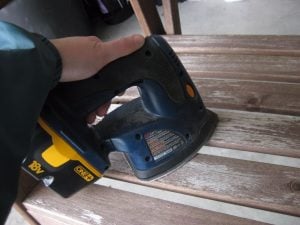[AdSense-A]You’ve probably already figured out that there are many different types of sanders, with each having their own specialized uses. Some sanders can be quite versatile with being a sort of one sander that does all. On the other hand, there are some which are more specialized then others and are better suited for a specific type of DIY project.
Whether you’ll in the market for a sander that does all or are looking to putting your finishing touches on your latest project, picking up the right sander may either make it or break it. Whether you’ll looking for the best type of sander for hardwood floors, are looking for something to help sand unique shapes, or are looking for something large, and with a great deal of raw power, there’s certainly something for everyone.
Helping you understand what the different types of electric sanders are, their uses, and are best suited for, the  following details all there is to know on five distinct electric sanders.
following details all there is to know on five distinct electric sanders.
Belt Sanders Description and Uses
Belt sanders come in all different sizes, but one constant remains as there some of the most aggressive sanders on the market. The aggressive nature not only helps save a significant amount of time, but makes them one of the enjoyable power tools you will find. Perfect for stripping large amount of stock in a relatively short amount of time, and can be used for sanding a wide array of material such as wood, hardwood flooring, aluminum, metal, and virtually anything you can imagine.
Belt sanders are used for material that is flat, and the perfect adaption for rough surfaces that need a great deal of sanding. This type of electric sander is perfect for both large and small projects, and are best used in conjunction with other types of sanders. Safety is definitely a must as they operate with an extreme amount of power which if handled improperly, can be a very dangerous tool.
Orbital and Random Orbital Sanders Description and Uses
Probably the most common and versatile sander you will find, orbital sanders can be used for virtually any kind of DIY project. The portability, lightweight, cost, and versatility makes is a must have for the avid enthusiast much less the DIY professional in you. Despite the compact size, it’s represents a great deal of power, precision, and balance that makes it a must have for DIY’ers.
Check Out More on How to Use an Orbital Sander
Orbital and random orbital sanders can be used for virtually any project, and does a really good job with each. This type of sander isn’t shouldn’t be your first choice for sanding large amounts of stock, but instead, is better suited as a finishing sander or smaller projects in comparison. Aside from the portability, it’s precision is its best aspect as it’s the easiest sander to control and is perfect for both novice and beginners alike.
Belt and Disk Sanders Description and Uses
Belt and disk sanders are a combo sander that brings out the best in most worlds. Offering a dual purpose sander that is great for both power, precision, and performance. This dual purpose sander comes attached to a base, and depending can easily be moved from one location to another.
The belt sander can be equipped with differing sizes of sanding belts and can be adjusted to different angles while also horizontally and vertically.
Oscillating Spindle Sander Description and Uses
Oscillating spindle sanders is a type of specialized power sander that you may, or may not ever use. An oscillating spindle protrudes through the top of a base which is best used for sanding wood in different shapes, curves, and angles.
The spindle which can be seen through the top of the base and is sometimes known as a dual purpose drum sander. The spindle, which can be outfitted with different diameters for sanding various shapes and sizes. The oscillating motion not only moves in an up and down fashion, but circular as well.
Floor Sanders
There are numerous types of floor sanders including edgers, drum sanders and belt sanders. Floor sanders are perfect for refinishing and re-purposing hardwood floors. Different types of floor sanders are best used for different areas of the floor and the type of project itself. For instance, belt and drum sanders are better suited for larger projects such as rough surfaces and an edger sander which is best for sanding in corners and along the walls.
Check Out 10 Amazing Tips on How to Sand Hardwood Floors
[AdSense-A]





